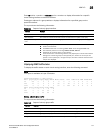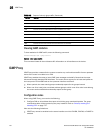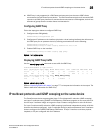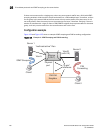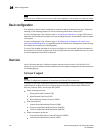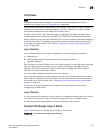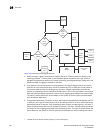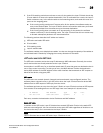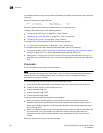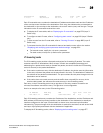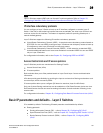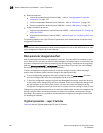
PowerConnect B-Series FCX Configuration Guide 785
53-1002266-01
Overview
26
IP interfaces
NOTE
This section describes IPv4 addresses. For information about IPv6 addresses on all other
PowerConnect devices, refer to “IPv6 addressing” on page 198.
Layer 3 Switches and Layer 2 Switches allow you to configure IP addresses. On Layer 3 Switches, IP
addresses are associated with individual interfaces. On Layer 2 Switches, a single IP address
serves as the management access address for the entire device.
All Layer 3 Switches and Layer 2 Switches support configuration and display of IP addresses in
classical subnet format (for example: 192.168.1.1 255.255.255.0) and Classless Interdomain
Routing (CIDR) format (for example: 192.168.1.1/24). You can use either format when configuring
IP address information. IP addresses are displayed in classical subnet format by default but you
can change the display format to CIDR. Refer to “Changing the network mask display to prefix
format” on page 869.
Layer 3 Switches
Layer 3 Switches allow you to configure IP addresses on the following types of interfaces:
• Ethernet ports
• Virtual routing interfaces (used by VLANs to route among one another)
• Loopback interfaces
Each IP address on a Layer 3 Switch must be in a different subnet. You can have only one interface
that is in a given subnet. For example, you can configure IP addresses 192.168.1.1/24 and
192.168.2.1/24 on the same Layer 3 Switch, but you cannot configure 192.168.1.1/24 and
192.168.1.2/24 on the same Layer 3 Switch.
You can configure multiple IP addresses on the same interface.
The number of IP addresses you can configure on an individual interface depends on the Layer 3
Switch model. To display the maximum number of IP addresses and other system parameters you
can configure on a Layer 3 Switch, refer to “Displaying and modifying system parameter default
settings” on page 321.
You can use any of the IP addresses you configure on the Layer 3 Switch for Telnet, Web
management, or SNMP access.
Layer 2 Switches
You can configure an IP address on a Layer 2 Switch for management access to the Layer 2 Switch.
An IP address is required for Telnet access, Web management access, and SNMP access.
You also can specify the default gateway for forwarding traffic to other subnets.
IP packet flow through a Layer 3 Switch
Figure 126 shows how an IP packet moves through a Layer 3 Switch.
FIGURE 126 IP Packet flow through a Layer 3 Switch



